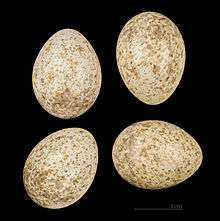Lesser short-toed lark
The lesser short-toed lark (Alaudala rufescens) is a small passerine bird found in the southern Palearctic ncluding North Africa. It is a common bird with a very wide range and the International Union for Conservation of Nature has rated its conservation status as being of "least concern".[1] Confusingly, Hume's short-toed lark is also sometimes called the lesser short-toed lark.
| Lesser short-toed lark | |
|---|---|
 | |
| On Fuerteventura, Canary Islands, Spain | |
| Scientific classification | |
| Kingdom: | Animalia |
| Phylum: | Chordata |
| Class: | Aves |
| Order: | Passeriformes |
| Family: | Alaudidae |
| Genus: | Alaudala |
| Species: | A. rufescens |
| Binomial name | |
| Alaudala rufescens (Vieillot, 1819) | |
| Synonyms | |
| |

Taxonomy and systematics
The Lesser short-toed lark was originally described as belonging to the genus Alauda. The genus name Alaudala is a diminutive of Alauda, and the specific rufescens is Latin for "reddish", from rufus "red".[2] Alternate names for the lesser short-toed lark include the common short-toed lark, grey lark, rufous short-toed lark and short-toed lark. Formerly or presently, some authorities considered the Athi short-toed lark, Asian short-toed lark and/or the Somali short-toed lark to be subspecies of the lesser short-toed lark.
A molecular phylogenetic study published in 2020 compared the nuclear and mitochondrial DNA from the sand, Asian short-toed, and lesser short-toed larks. The study analysed samples from 130 individuals that represented 16 of the 18 recognised subspecies. The resulting phylogenetic tree indicated that neither the Asian short-toed lark, nor the lesser short-toed lark as currently defined are monophyletic. Most of the subspecies were also found to be non-monophyletic. The authors refrained from proposing a revised taxonomy until additional studies had been completed comparing the vocalizations, sexual behaviour and ecology.[3]
Subspecies
Nine subspecies are recognized:[4]
- A. r. rufescens - (Vieillot, 1819): Found on Tenerife (west-central Canary Islands)
- A. r. polatzeki - (Hartert, 1904): Found in eastern Canary Islands
- A. r. apetzii - (Brehm, AE, 1857): Found in eastern and southern Iberian Peninsula
- A. r. minor - (Cabanis, 1851): Found from Morocco to north-western Egypt and southern Turkey to the Sinai Peninsula and eastern Iraq
- A. r. nicolli - (Hartert, 1909): Found in the Nile Delta (northern Egypt)
- A. r. pseudobaetica - (Stegmann, 1932): Found in eastern Turkey, Transcaucasia and northern Iran
- A. r. heinei - (Homeyer, 1873): Found from Ukraine to eastern Kazakhstan
- A. r. aharonii - (Hartert, 1910): Found in central Turkey
- A. r. persica - Sharpe, 1890: Found in eastern and southern Iraq to southern and south-western Afghanistan
Description
The lesser short-toed lark is similar in size and appearance to the greater short-toed lark but is generally a duller-looking bird with a more streaked breast. It grows to a length of from 13 to 14 cm (5.1 to 5.5 in) and the sexes are similar. As with the greater short-toed lark, the colour varies across the broad range and is not a good distinguishing feature. It is dark-streaked greyish-brown above, and white below. It has a pale supercilium, and a short stubby bill.[5]
Care must be taken to distinguish this species from the Calandrella larks. This species lacks the dark neck patches of the greater, and has fine streaking across the breast. The bill and head shape also differ, this species having a shorter, less-conical bill and a more-rounded, smaller head. The song is richer, more varied and imitative than that of its relative.[5]
Distribution and habitat
The lesser short-toed lark breeds in Spain, north Africa, also including Turkey eastwards across the semi-deserts of central Asia to Mongolia and China. Many populations, including the Spanish and African breeders, are sedentary (non-migratory), but some Asian birds from the north of the breeding range migrate south in winter. This species is a very rare wanderer to northern and western Europe.[1]
Behaviour and ecology
This is a bird of dry open country, preferring even drier and barer soils than the greater short-toed lark. It nests on the ground, laying two or three eggs. Its food is seeds and insects, the latter especially in the breeding season.[6]
References
- BirdLife International (2012). "Calandrella rufescens". IUCN Red List of Threatened Species. 2012. Retrieved 26 November 2013.CS1 maint: ref=harv (link)
- Jobling, James A (2010). The Helm Dictionary of Scientific Bird Names. London: Christopher Helm. pp. 37, 341. ISBN 978-1-4081-2501-4.
- Ghorbani, F.; Aliabadian, M.; Zhang, R.; Irestedt, M.; Hao, Y.; Sundev, G.; Lei, F.; Ma, M.; Olsson, U.; Alström, P. (2020). "Densely sampled phylogenetic analyses of the Lesser Short-toed Lark (Alaudala rufescens) — Sand Lark (A. raytal) species complex (Aves, Passeriformes) reveal cryptic diversity". Zoologica Scripta. 00: 1–13. doi:10.1111/zsc.12422.
- Gill, Frank; Donsker, David; Rasmussen, Pamela, eds. (2020). "Nicators, reedling, larks". IOC World Bird List Version 10.1. International Ornithologists' Union. Retrieved 9 May 2020.
- Mark Beaman; Steve Madge (1998). The Handbook of Bird Identification: For Europe and the Western Palearctic. Christopher Helm. p. 547. ISBN 978-0-7136-3960-5.
- "Lesser Short-toed Lark (Calandrella rufescens)". Handbook of the Birds of the World Alive. Lynx Edicions. Retrieved 17 November 2016.
